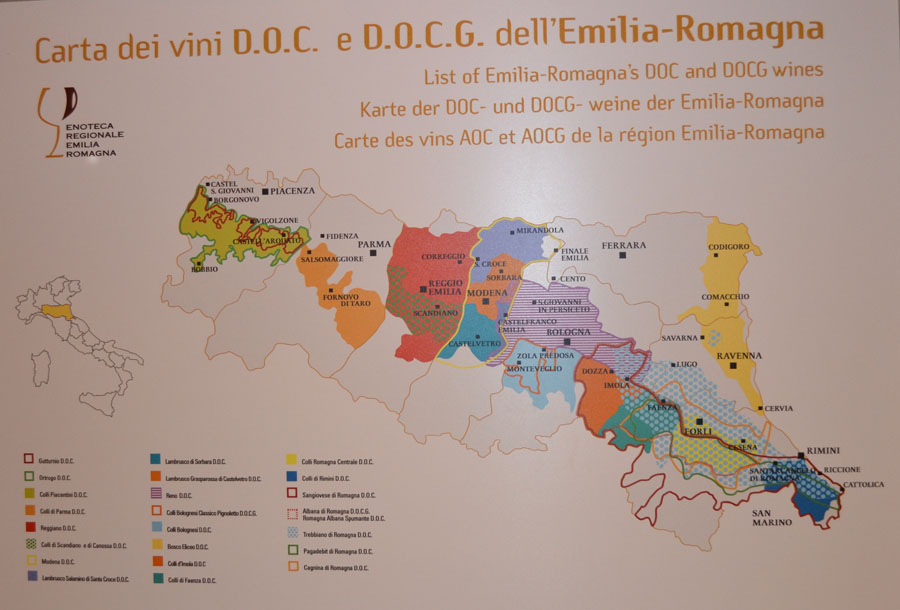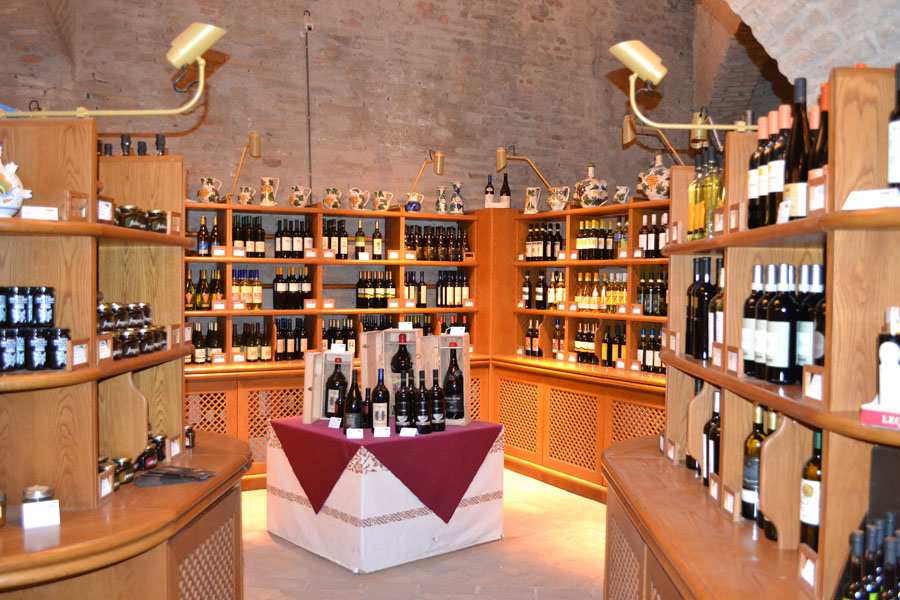The Emilia-Romagna region has a growing relevance in the world of Italian wines. It produces 15% of Italian wine and has seen a steady increase in exports, with the biggest markets represented by Germany, the United States, England, Switzerland, and increasingly Russia, China and Brasil.
HISTORY
To understand how the production of wine has evolved here, you need to understand how Emilia and Romagna, which together form the region, experienced two different conquest histories. Emilia was settled by Barbarian populations, whose diet relied heavily on butter and pork meat; these leave a sensation of fatness in the mouth, which can be balanced out by a sparkling wine; in fact, Emilia is a big producer and exporter of sparkling wines. Romagna, on the other hand, was colonized by the Romans, who used olive oil, which leaves an oily, not fatty, sensation in the mouth, needing wine with a certain structure to restore balance of flavors in the mouth. This also explains why food and wine pairing is so important!

PRIMARY TYPES OF WINES
Below is a list of the main wines by geographic area, but be aware that there are many variations on the same vine and smaller productions as well.
1. Colli Piacentini: the hills and valleys around Piacenza, in the north-western tip of the region. The two most important wines produced here are:
- Gutturnio. Its names derives from the latin word gutturnum, the name of a cup that the Romans used for drinking during festivities. Gutturnio is a bright, ruby red wine, traditionally sparkling and young; it goes well with soups, red and white meat roasts, and fried dishes.
- Malvasia. Aromatic white wine, characterized by many fragrances. The dry version goes well with appetizers, pasta, white meat and fish. The most famous version is Malvasia di Candia.
2. Colli di Parma: proceeding south along the Via Emilia, the old Roman road that cuts the region diagonally, we encounter the enchanting hills around Parma, between the Enza and Stirano rivers. The main wines around here are:
- Malvasia. See above.
- Barbera. Ruby red wine with an intense color. Dry, full-bodied, intense flavor. It is excellent with boiled pork and roasted lamb.
- Bonarda. Ruby red wine with a fruity bouquet and a flavor that varies from dry to sweet. Ideal with pasta with meat sauce, roasted meat and sharp cheeses.
3. Parma, Reggio Emilia and Modena: further south along the via Emilia, we find the lands of:
- Lambrusco. Red wine, ranging from a ruby to intense red color, it has a fruity to floreal fragrance, a pleasant acidity and a moderate alcoholic content. The regular version (fizzy) pairs well with pasta with beans (pasta e fagioli) and boiled meat, while the spumante and semi-sparkling versions are excellent with appetizers, cold-cut meats and medium-aged cheeses. Please note that there are many different versions of Lambrusco!
4. Colli Bolognesi: the hills around Bologna, in the central part of the region.
- Pignoletto. Cited by Plinio il Vecchio in the I° century B.C., it was recognized as the second DOCG of Emilia-Romagna in 2010. Prestigious white wine, with a light yellow color, it has a delicate flavor and well-balanced taste. Excellent with appetizers, broth tortellini and seafood.
5. Romagna: this is the area occupying the south-eastern portion, characterized by hills where some of the most famous wines of the region are produced, including:
- Albana. The first white wine in Italy to obtain the DOCG recognition (1987), it has been produced since Roman times. It is made in four versions, including dry, which goes well with any type of food, and sweet, perfect with cakes.
- Sangiovese. The red wine of the area! Ruby-red color with violet nuances, dry, full, harmonic taste, it is excellent with roasts and grilled meats.
(Source: Vini dell’Emilia-Romagna by Enoteca Regionale Emilia Romagna)
Want to learn more? Visit Enoteca Regionale Emilia Romagna. This association has been promoting the wines of Emilia-Romagna since 1978 and has a beautiful, well-stocked wine cellar in the basement of a 13th-century fortress (Rocca Sforzesca) in the village of Dozza, 35 minutes from Bologna.
What’s your favorite Emilia-Romagna wine?




Very interesting article. I’m from Bologna but I didin’t know,for example, that Pignoletto comes from Colli Bolognesi. So now I learnt more about whines in my region as well I learnt about how the Parmiggiamo Reggiano is made, my favorite cheese!
Good job, Silvia
Maria Cristina
So glad you found the articles interesting and learned something new!
– Silvia
After reading the article I’ll visit Dozza. I live in bologna but so far I never visited Dozza. The place seems very nice and interesting for historical buildings and for local wines. History, food and drink at few chilometers from Bologna what else can you wish? Thanks to Silvia and her complete information I feel stimulated to go to Dozza as soon as possible.
Very interesting also the information about “gelato” and “parmiggiano”.
Claudio
I’m glad I inspired you to see a new place close to where you live! It’s easy to overlook what we have close to home to visit far away locations. And Dozza is indeed a great destination, lots to see and an excellent food and wine experience!
– Silvia
Pignoletto all the way!
I have to admit…I agree!!!
I adore Sangiovese can’t wait to be back in Bologna and enjoy a glass with my pasta and meat sauce.
I love Sangiovese, can’t wait to be back in Bologna to enjoy a glass with pasta and meat sauce.
I love Sangiovese, too!!! And many others from the region… 😉
I’ve been looking for good and informative articles about wines of Emilia-Romagna and then i found yours! Emilia-Romagna is often overlooked by international wine lovers. Looking forward to read more post from you! 🙂 Cheers
Thank you Macy for stopping by 🙂 Glad you thought the article was useful. I agree, Emilia-Romagna wines are too often overlooked. I sure love them!
Silvia,
Great article, I can’t wait to try these wines. Can you recommend a local with knowledge to take us to some wineries in the region? We are arriving in Bologna in March.
Thanks
Sean
Hi Sean, I don’t know about a specific person who does that, but I’d contact the Enoteca Regionale https://www.enotecaemiliaromagna.it/en/, and ask them. Eventually, I want to offer some wine focused tours myself, but for now I’m not able to help you…sorry! Hope you have a great time in Bologna.